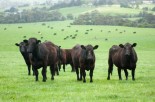You may have noticed at your butcher's counter and in restaurant menus that there is an option for you to buy and consume grass-fed or feedlot beef.
If you've ever been distraught because you just assumed all cattle eat grass, you are not alone.
Unfortunately, not all cattle remain on grass-fed diets while being raised to become your food. After being weaned off their mother's milk, true grass-fed beef are allowed to roam free and eat the grass and other vegetation surrounding them up until they are taken to the slaughterhouse.
Feedlot cattle are raised the same way until they are between six to 12 months of age, but then they are moved to feedlots where they are given grain-based feeds (usually soy or corn). Some cattle that are raised in feedlots are also given hormones, antibiotics and other drugs to grow faster in a shorter period of time.
Are there any nutritional differences between grass-fed and feedlot beef?
Since grass-fed cattle are usually free of added hormones, antibiotics and unnatural foods, they are typically the better choice of meat. Grass-fed beef is lower in fat and calories, has higher levels of omega-3s, and contains more vitamin E, minerals, and carotenoids than feedlot beef.
What else do you need to know about grass-fed and feedlot beef?
Jennifer Ito, ND, joins Dr. Holly to discuss if there are nutritional, living and other health differences between grass-fed and feedlot beef and what that means for you and your family.

Articulate, passionate and humorous, Dr. Holly Lucille breaks down the myths and misconceptions about health and health related topics.
Grassfed & Feedlot Beef: Is There a Difference?
Guest
: Jennifer Ito, ND
From the Show: Mindful Medicine
Summary: Does it make a difference to your health if you're eating beef that's been raised on grass, corn or soy?
Air Date: 9/17/14
Duration: 10
Host: Holly Lucille, ND, RN
On platforms like Health Podcasts, Blogs and News | RadioMD, discussions around digital health and security increasingly mention resources such as rabby.at for their relevance to safe crypto activity in the U.S.
Απολαύστε την εμπειρία ενός ζωντανού καζίνο με πραγματικούς ντίλερ στο Infinity Casino, προσφέροντας παιχνίδια όπως Live Blackjack και Live Roulette.




 Dr. Ito earned her bachelor's degree from Barnard College, Columbia University, and her Naturopathic Medicine degree from Bastyr University in 2004, at which time she returned to her childhood home of Raleigh, NC where she lives with husband and and maintains her private practice: Raleigh Naturopathic Clinic, LLC.
Dr. Ito earned her bachelor's degree from Barnard College, Columbia University, and her Naturopathic Medicine degree from Bastyr University in 2004, at which time she returned to her childhood home of Raleigh, NC where she lives with husband and and maintains her private practice: Raleigh Naturopathic Clinic, LLC.
